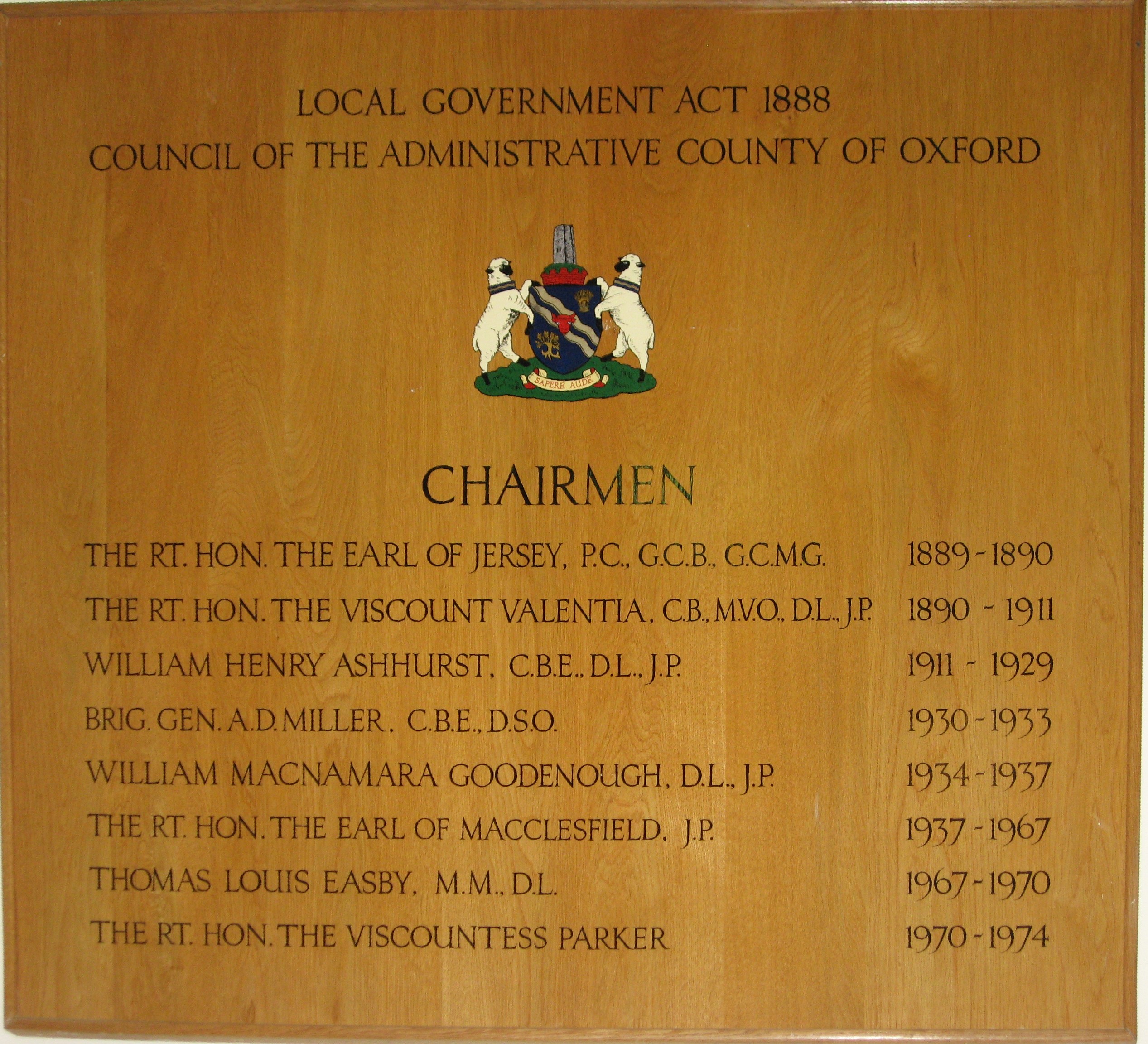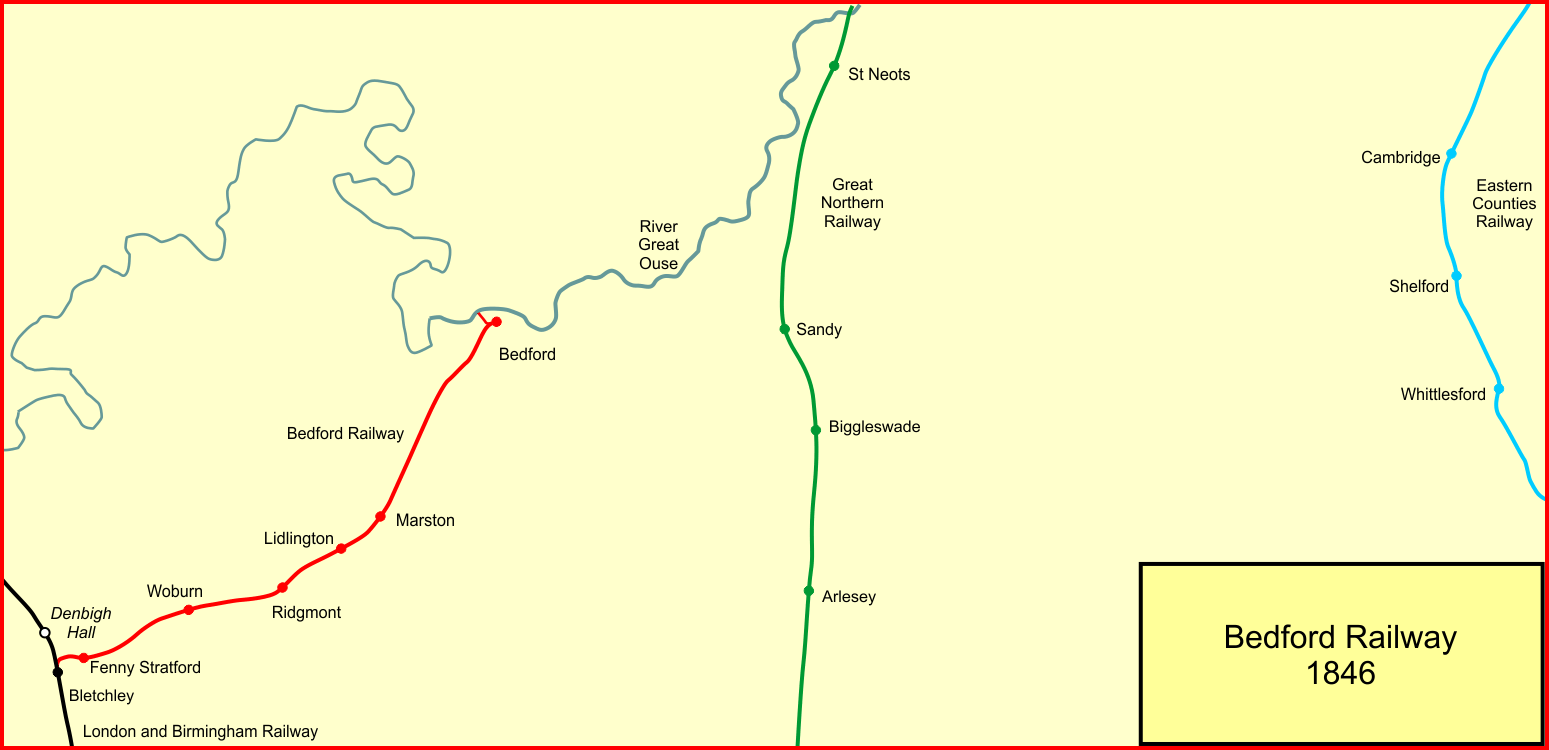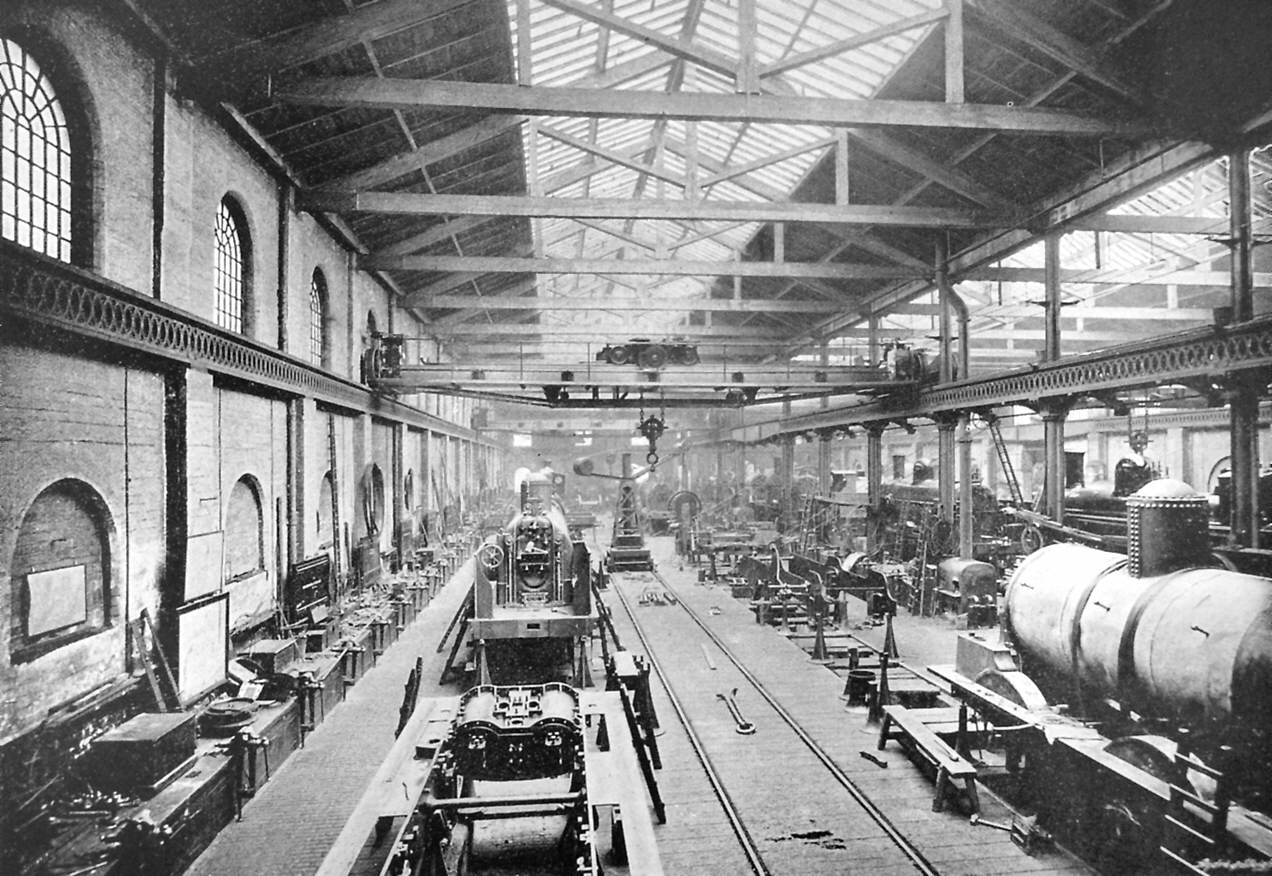|
Oxford–Bicester Line
The Oxford–Bicester line is a railway line linking Oxford and Bicester in Oxfordshire, England. Opened in 1850, later becoming part of a through route to Cambridge, it closed in 1967 along with much of the rest of the original line. The section between Oxford and Bicester was reopened in 1987 as a branch line, and closed from early 2014 to late 2015 for a substantial upgrade in which it became part of a new route between Oxford and via High Wycombe. In addition, it is intended that by 2025 the original route eastwards will be restored as far as Bletchley allowing services to run to Bedford. This East West Rail project includes a long-term plan to re-establish the route through to . History Opening and original operation The line was opened in 1850 as part of the Buckinghamshire Railway, which in 1879 became part of the London and North Western Railway. In the grouping of Britain's railways in 1923 the L&NWR became part of the London, Midland and Scottish Railway, and ... [...More Info...] [...Related Items...] OR: [Wikipedia] [Google] [Baidu] |
Bletchley
Bletchley is a constituent town of Milton Keynes, Buckinghamshire, England, in the south-west of the city, split between the civil parishes in England, civil parishes of Bletchley and Fenny Stratford and West Bletchley, which In 2011 had a combined population of 37,114. Bletchley is best known for Bletchley Park, the headquarters of Britain's World War II codebreaking organisation, and now a major tourist attraction. The National Museum of Computing is also located on the Park. History Origins and early modern history The town name is Old English, Anglo-Saxon and means ''Blæcca's clearing''. It was first recorded in Manorialism, manorial rolls in the 12th century as ''Bicchelai'', then later as ''Blechelegh'' (13th century) and ''Blecheley'' (14th–16th centuries). Just to the south of Fenny Stratford, there was Romano-British town, ''Magiovinium, M'' on either side of Watling Street, a Roman road. Bletchley was originally a minor village on the outskirts of Fenny Stratfo ... [...More Info...] [...Related Items...] OR: [Wikipedia] [Google] [Baidu] |
Oxfordshire County Council
Oxfordshire County Council is the county council (upper-tier local authority) for the non-metropolitan county of Oxfordshire in the South East of England. Established in 1889, it is an elected body responsible for most strategic local government services in the county. Oxfordshire County Council provides a wide range of services, including education (schools, library, libraries and youth services), social services, public health, highway maintenance, waste disposal, emergency planning, consumer protection and town and country planning for matters to do with minerals, waste, highways and education. This makes it one of the largest employers in Oxfordshire, with a gross expenditure budget of £856.2 million in 2021–22. History Elected county councils were first introduced in England and Wales in 1889 as a result of the Local Government Act 1888, taking over administrative functions until then carried out by unelected magistrates at the quarter sessions. The areas covered by cou ... [...More Info...] [...Related Items...] OR: [Wikipedia] [Google] [Baidu] |
Network SouthEast
Network SouthEast (NSE) was one of the three passenger sectors of British Rail created in 1982. NSE mainly operated commuter rail trains within Greater London and inter-urban services in densely populated South East England, although the network went as far west as Exeter and also covered the inner East of England. Before 1986, the sector was originally known as ''London & South Eastern''. During the privatisation of British Rail, it was gradually divided into a number of franchises. History Before the History of rail transport in Great Britain 1948 - 1994#The 1980s : Sectorisation, sectorisation of British Rail (BR) in 1982 the system was split into largely autonomous regional operations: those operating around London were the London Midland Region, Southern Region of British Railways, Southern Region, Western Region of British Railways, Western Region, and Eastern Region of British Railways, Eastern Region. Sectorisation of BR changed this setup by organising by the traff ... [...More Info...] [...Related Items...] OR: [Wikipedia] [Google] [Baidu] |
Varsity Line
The Varsity Line was the main railway line that linked the English university cities of Oxford and Cambridge, operated by the London and North Western Railway. In World War II, the line became a strategic route for freight avoiding London, and additional connections were made to nearby lines to improve it, but it was not greatly used for its intended purpose. After the war, the line was again scheduled to be developed as a strategic route, but that scheme was never fully implemented either. Passenger services were withdrawn from most of the line on 1 January 1968, and only the Bletchley–Bedford section remained open for passenger traffic. In 1987, the section between Oxford and Bicester was reopened, followed in 2015 by a connection to the Chiltern Main Line at Bicester, enabling Chiltern Railways to operate an Oxford to London passenger service. There are funded plans for the entire line to be re-established by the mid-2020s, partly on a new route and under a new name Ea ... [...More Info...] [...Related Items...] OR: [Wikipedia] [Google] [Baidu] |
Bedford And Cambridge Railway
Bedford is a market town in Bedfordshire, England. At the 2011 Census, the population was 106,940. Bedford is the county town of Bedfordshire and seat of the Borough of Bedford local government district. Bedford was founded at a ford on the River Great Ouse and is thought to have been the burial place of King Offa of Mercia, who is remembered for building Offa's Dyke on the Welsh border. Bedford Castle was built by Henry I, although it was destroyed in 1224. Bedford was granted borough status in 1166 and has been represented in Parliament since 1265. It is known for its large population of Italian descent. History The name of the town is believed to derive from the name of a Saxon chief called Beda, and a ford crossing the River Great Ouse. Bedford was a market town for the surrounding agricultural region from the early Middle Ages. The Anglo-Saxon King Offa of Mercia was buried in the town in 796;Simon Keynes, "Cynethryth", in Lapidge, ''Encyclopaedia of Anglo-Saxon Engla ... [...More Info...] [...Related Items...] OR: [Wikipedia] [Google] [Baidu] |
Marston Vale Line
The Marston Vale line is the line between and in England, a surviving remnant of the former Varsity Line between and , most of which was closed in the late 1960s. The line is sponsored by the Marston Vale community rail partnership. The line is to be adopted and upgraded as part of East West Rail, a project underway to re-establish the OxfordCambridge route. History The line was authorised by the ( 8 & 9 Vict. c. xliii), and opened in 1846 by the London and Birmingham Railway, though the L&B merged with the Grand Junction Railway to become the London and North Western Railway whilst construction was ongoing – the LNWR ran it from its opening."Bedford Railway" 'Disused Stations Site Record''; Retrieved 7 September 2016 The line later became part of the cross-country |
British Rail
British Railways (BR), which from 1965 traded as British Rail, was a state-owned company that operated most rail transport in Great Britain from 1948 to 1997. Originally a trading brand of the Railway Executive of the British Transport Commission, it became an independent statutory corporation in January 1963, when it was formally renamed the British Railways Board. British Railways was formed on 1 January 1948 as a result of the Transport Act 1947, which nationalised the Big Four British railway companies along with some other (but not all) smaller railways. Profitability of the railways became a pressing concern during the 1950s, leading to multiple efforts to bolster performance, including some line closures. The 1955 Modernisation Plan formally directed a process of dieselisation and electrification to take place; accordingly, steam locomotives had been entirely replaced by diesel and electric traction (except for the narrow-gauge Vale of Rheidol Railway tourist lin ... [...More Info...] [...Related Items...] OR: [Wikipedia] [Google] [Baidu] |
Transport Act 1947
The Transport Act 1947 ( 10 & 11 Geo. 6. c. 49) was an Act of Parliament of the Parliament of the United Kingdom. Under the terms of the Act, the railway network, long-distance road haulage and various other types of transport were nationalised and came under the administration of the British Transport Commission. The BTC was responsible to the Ministry of Transport for general transport policy, which it exercised principally through financial control of a number of executives set up to manage specified sections of the industry under schemes of delegation. Overview The Act was part of the nationalisation agenda of Clement Attlee's Labour government, and took effect from 1 January 1948. In Northern Ireland, the Ulster Transport Authority acted in a similar manner. The government also nationalised other means of transport such as: canals, sea and shipping ports, bus companies, and eventually, in the face of much opposition, road haulage. All of these transport modes, including ... [...More Info...] [...Related Items...] OR: [Wikipedia] [Google] [Baidu] |
London, Midland And Scottish Railway
The London, Midland and Scottish Railway (LMSIt has been argued that the initials LMSR should be used to be consistent with London and North Eastern Railway, LNER, Great Western Railway, GWR and Southern Railway (UK), SR. The London, Midland and Scottish Railway's corporate image used LMS, and this is what is generally used in historical circles. The LMS occasionally also used the initials LM&SR. For consistency, this article uses the initials LMS.) was a British railway company. It was formed on 1 January 1923 under the Railways Act 1921, which required the grouping of over 120 separate railways into four. The companies merged into the LMS included the London and North Western Railway, the Midland Railway, the Lancashire and Yorkshire Railway (which had previously merged with the London and North Western Railway on 1 January 1922), several Scottish railway companies (including the Caledonian Railway), and numerous other, smaller ventures. Besides being the world's largest ... [...More Info...] [...Related Items...] OR: [Wikipedia] [Google] [Baidu] |
Railways Act 1921
The Railways Act 1921 ( 11 & 12 Geo. 5. c. 55), also known as the Grouping Act, was an act of Parliament enacted by the British government, and was intended to stem the losses being made by many of the country's 120 railway companies, by "grouping" them into four large companies, dubbed the " Big Four". The system of the "Big Four" lasted until the nationalization of the railways in 1947. During World War I, the British government took control, although not ownership, of British railways. The intention was to reduce inefficient internal competition between railway companies, and retain some of the benefits which the country had derived from a government-controlled railway system during the war. The provisions of the act took effect from the start of 1923. History The British railway system had been built up by more than a hundred railway companies, large and small, and often, particularly locally, in competition with each other. The parallel railways of the East Midlands, and ... [...More Info...] [...Related Items...] OR: [Wikipedia] [Google] [Baidu] |
London And North Western Railway
The London and North Western Railway (LNWR, L&NWR) was a British railway company between 1846 and 1922. In the late 19th century, the LNWR was the largest joint stock company in the world. Dubbed the "Premier Line", the LNWR's main line connected four of the largest cities in England; London, Birmingham, Manchester and Liverpool, and, through cooperation with their Scottish partners, the Caledonian Railway also connected Scotland's largest cities of Glasgow and Edinburgh. Today this route is known as the West Coast Main Line. The LNWR's network also extended into Wales and Yorkshire. In 1923, it became a constituent of the London, Midland and Scottish (LMS) railway, and, in 1948, the London Midland Region of British Railways. History The company was formed on 16 July 1846 by the ( 9 & 10 Vict. c. cciv), which authorised the amalgamation of the Grand Junction Railway, London and Birmingham Railway and the Manchester and Birmingham Railway. This move was prompted, in ... [...More Info...] [...Related Items...] OR: [Wikipedia] [Google] [Baidu] |






